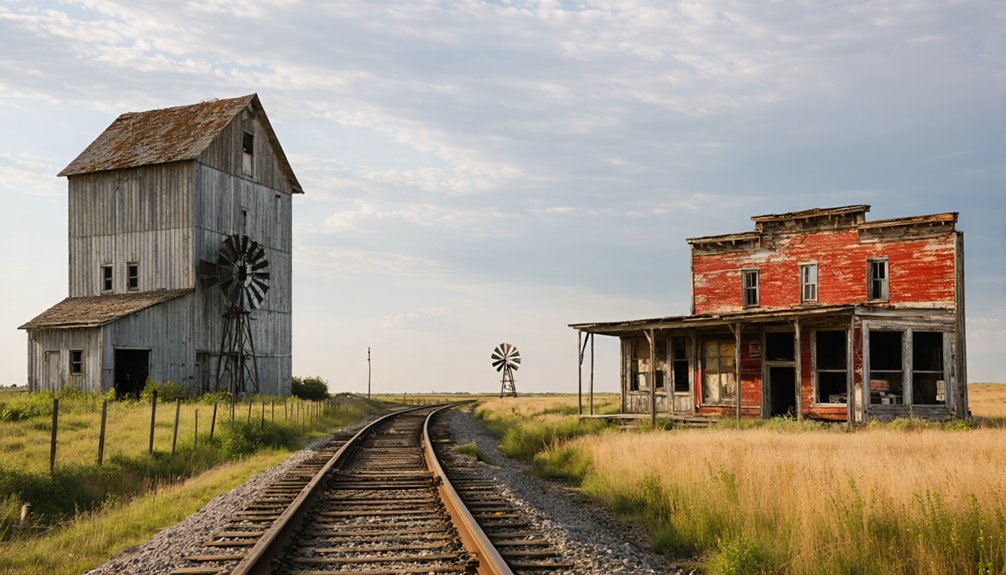You won’t find a ghost town called Minneapolis in South Dakota – this is a common misconception that’s been debunked by historical records and state archives. While South Dakota boasts numerous fascinating ghost towns in the Black Hills region, including Deadwood, Rochford, and Spokane, Minneapolis isn’t among them. The real Minneapolis is Minnesota’s largest city. The rich history of South Dakota’s authentic ghost towns tells compelling stories of mining booms, railroad ventures, and pioneer dreams.
Key Takeaways
- Minneapolis is not a real ghost town in South Dakota – it is commonly confused with Minnesota’s largest city.
- No federal or state registries provide evidence of a Minneapolis ghost town ever existing in South Dakota.
- Historical records and documentation show no credible proof of a settlement called Minneapolis in South Dakota’s mining regions.
- Ghost town myths often emerge from misidentified locations, with towns like Tinton and Smithwick sometimes mistaken for Minneapolis.
- South Dakota’s authentic ghost towns are primarily located in the Black Hills region, focused around historic mining operations.
Setting the Record Straight
While many people confuse it with its larger Minnesota namesake, Minneapolis, South Dakota stands as a distinct ghost town roughly one mile northeast of Rochford in Pennington County.
You’ll find this forgotten settlement’s ghost town origins deeply rooted in the late 19th century mining boom, where numerous shallow mines once dotted the landscape along Silver Creek. Like many river towns and hamlets in Hennepin County, this settlement’s destiny was shaped by changing economic forces.
Unlike its Minnesota counterpart, this Minneapolis emerged as a bustling mining community with its own mill facility processing locally extracted ore. Similar to the town of Mystic, economic decline and flooding contributed to its eventual abandonment.
The mining community dynamics followed a familiar pattern seen throughout the Black Hills – rapid growth followed by eventual abandonment as mineral wealth dwindled.
Today, you can explore the abandoned buildings and mill ruins that tell the story of this lesser-known piece of South Dakota’s mining heritage.
Historical Documentation and Research
Although primary sources about Minneapolis, South Dakota remain scarce, dedicated researchers can piece together the town’s history through various archival materials.
You’ll find historical plat maps and land ownership documents that reveal essential details about the town’s founding and layout. Census records and post office registrations help track the population’s rise and fall, while period newspapers document daily life and pivotal events.
Similar to other towns established along railway lines, Minneapolis emerged as one of many settlements placed every seven miles to service steam locomotives.
To uncover the town’s historical significance, you’ll want to examine government and territorial records that verify official recognition dates and status changes. Similar to how ghost town hunting requires patient research, investigators must carefully examine multiple historical documents to reconstruct Minneapolis’s past.
Government and territorial records reveal key milestones in a town’s history by documenting official dates and changing legal status.
The most valuable archival resources often include National Register of Historic Places surveys, which evaluate remaining structures and sites. These combined sources create a clearer picture of Minneapolis’s emergence, peak years, and eventual decline.
Notable Ghost Towns of South Dakota
South Dakota’s landscape is dotted with remnants of once-thriving communities, from the iconic gold rush town of Deadwood to the lesser-known prairie settlement of Cottonwood.
These forgotten legends tell tales of boom-and-bust cycles, where eerie folklore still echoes through abandoned streets and decaying structures. The historic McCahan Chapel still stands in Mystic as a testament to pioneer faith.
– Deadwood stands as the crown jewel of Black Hills ghost towns, transforming from a lawless mining camp to today’s gaming destination.
The Great Depression devastated many small towns, including Capa which saw its population plummet from a peak of three hundred residents.
- Spokane, nestled near Custer State Park, remains one of the state’s best-preserved ghost towns.
- Rochford, known as the “friendliest ghost town,” maintains its rustic mining-era charm.
- Lead survived near-abandonment to reinvent itself around the historic Homestake Mine.
- Cottonwood represents the stark reality of prairie town decline, with just 11 residents remaining from its early 1900s peak.
Mining Settlements in the Black Hills
The discovery of gold in 1874 by Custer’s Expedition ignited one of America’s last great mineral rushes, transforming the Black Hills into a bustling frontier of mining settlements.
You’ll find the region’s mining heritage scattered across towns like Lead, Deadwood, Galena, and Rochford, where over 1,000 mines once operated.
As mining technology evolved from simple placer methods to advanced hard-rock extraction, larger operations like the Homestake Mine revolutionized the industry.
They’d use mercury amalgamation, chlorination, and eventually cyanide processing to extract both free-milling and refractory gold.
Today, ghost town exploration reveals the remnants of this era – abandoned mines, weathered buildings, and silent mills stand as evidence to the boom-and-bust cycles that defined these frontier communities.
The Treasure Coaches transporting gold frequently became targets for bandits and road agents during the rush era.
While some settlements survived, others faded into history when their precious resources ran dry. The Great Sioux War erupted in 1876 as thousands of miners violated Native American treaties by flooding into the region.
Preservation of South Dakota’s Ghost Towns
Through dedicated community education programs, local volunteers work alongside preservation experts to maintain structural integrity while cataloging artifacts and conducting historic resource surveys.
The state’s grant programs and legal frameworks help protect these historic treasures, ensuring future generations can experience authentic remnants of South Dakota’s mining era.
You’ll find South Dakota’s ghost town preservation efforts rely heavily on a combination of historical documentation methods and strategic site protection plans established by the State Historical Society.
Current protection efforts are focused on preventing commercial mining activities that could damage these historic sites and their surrounding landscapes.
Historical Preservation Methods
Preserving South Dakota’s ghost towns requires a meticulous blend of technical standards, documentation practices, and institutional support to maintain their historical authenticity.
When you’re tackling preservation techniques and restoration challenges, you’ll need to follow established guidelines while working with local preservation commissions.
Key elements you’ll encounter in ghost town preservation include:
- Adherence to National Park Service Standards for grant eligibility
- Documentation through maps, photographs, and archival research
- Matching original materials and designs during repairs
- Coordination with the State Historic Preservation Office
- Use of historic rehabilitation funding and tax incentives
You’ll find success by prioritizing repairs over replacements and ensuring new materials match original specifications.
Communities like Galena’s Black Hills serve as prime examples of successful historical preservation through dedicated local efforts and storytelling initiatives.
Site Protection Strategies
While South Dakota’s ghost towns face ongoing threats from natural elements and human activity, implementing extensive site protection strategies remains vital for their survival.
You’ll find that effective preservation techniques include structural stabilization and careful environmental mitigation, particularly in areas affected by historic mining operations. Strategic site access controls help prevent vandalism while still allowing for meaningful exploration of these historic treasures.
To protect Minneapolis and similar ghost towns, you’ll see a combination of modern technology and traditional conservation methods at work. GPS mapping and drone surveys assist in monitoring site conditions, while careful restoration work follows established preservation standards.
Through partnerships between state agencies and private organizations, these protection strategies guarantee that future generations can experience South Dakota’s rich mining and settlement heritage.
Community Education Programs
Through vibrant community education initiatives, South Dakota’s ghost towns have become living classrooms for historical preservation.
You’ll find rich learning experiences through community workshops and storytelling events that connect you directly with the region’s mining heritage.
- Annual Galena Ghost Town Walk lets you explore at your own pace while learning from local historians
- Documentary screenings like “Galena: The Ghost Town that Came Back to Life” share firsthand accounts from residents
- The Deadwood Historic Preservation Commission funds educational preservation projects
- Graduate students create innovative media projects to keep ghost town stories alive
- The South Dakota Humanities Council sponsors programs linking ghost towns to cultural identity
These educational efforts guarantee that ghost town histories aren’t just preserved in books but remain vibrant parts of South Dakota’s living heritage.
Common Misconceptions and Historical Accuracy

You’ll find that Minneapolis isn’t actually a ghost town in South Dakota, despite persistent misconceptions suggesting otherwise.
The real Minneapolis stands as Minnesota’s largest city, while South Dakota’s authentic ghost towns cluster primarily in the Black Hills region and other historic mining areas.
When exploring South Dakota’s true ghost towns, you’ll discover abandoned settlements that arose from mining, railroad, and agricultural ventures – each with its own unique story of rise and decline.
Debunking Historical Location Claims
Despite widespread tales of a Minneapolis ghost town in South Dakota, historical records reveal no credible evidence of such a settlement ever existing.
You’ll find that ghost town myths often arise from misidentified locations and romanticized local folklore, rather than historical accuracy.
When investigating these claims, consider these essential facts:
- Towns like Tinton and Smithwick are frequently mistaken for the nonexistent Minneapolis site
- No federal or state registries document a Minneapolis ghost town in South Dakota
- Photographic evidence from the early 1900s shows other active mining communities instead
- Many “ghost towns” still maintain residential services and postal operations
- Local historical societies emphasize the importance of verifying abandoned town claims through multiple sources
These findings demonstrate how regional storytelling can create compelling but inaccurate historical narratives.
Setting Record Straight Geographically
When researching South Dakota’s ghost towns, it’s essential to understand that no town called Minneapolis ever existed within the state’s borders.
Despite geographic myths that sometimes arise due to regional proximity to Minnesota, historical records and state archives clearly show no evidence of a Minneapolis ghost town in South Dakota.
You’ll find that authentic South Dakota ghost towns typically cluster in the Black Hills region, bearing names that reflect local heritage, mining claims, or settler origins.
The state’s historical records document numerous abandoned settlements, from Spokane to Mystic, but Minneapolis isn’t among them.
While some ghost town locations have changed names over time, state historical societies and academic research confirm that Minneapolis has always been firmly rooted in Minnesota, not South Dakota.
Frequently Asked Questions
Are There Any Paranormal Investigations or Ghost Sightings Reported in the Area?
Despite 100+ ghost towns in South Dakota, you won’t find documented ghost hunting or spectral phenomena here – there’s no record of paranormal investigations in Minneapolis, SD’s abandoned settlement.
What Native American Tribes Originally Inhabited the Land Before Settlement?
You’ll find deep Sioux heritage in this land, where the Dakota people were the primary inhabitants. Their tribal history includes centuries of life here before European settlers arrived.
How Do Weather Conditions Affect Access to Local Ghost Town Sites?
Like a temperamental gatekeeper, weather impacts your access dramatically. You’ll face seasonal accessibility challenges including muddy spring roads, summer heat, autumn rains, and winter’s deep snow blocking exploration routes.
What Artifacts Have Been Recovered From Archaeological Digs in the Region?
You’ll find spear-points, tools, and historic bottles from careful excavation techniques, with artifact dating revealing items spanning 12,000 years, including the famous Browns Valley Points and ceramic pieces.
Are There Any Protected Species Living Among the Abandoned Structures Today?
Like silent guardians of history, you’ll find northern long-eared bats roosting in weathered rafters and protected raptors nesting in abandoned structures, while native prairie grasses shelter small mammals throughout these untamed habitats.
References
- https://www.minnesotahistory.org/post/a-complete-guide-to-the-ghost-towns-of-hennepin-county
- https://973kkrc.com/creepiest-haunted-place-in-south-dakota-minnesota-and-iowa/
- https://www.youtube.com/watch?v=yVWWqwcGTt0
- https://www.sdpb.org/rural-life-and-history/2023-08-21/some-black-hills-ghost-towns-and-their-origins
- https://www.youtube.com/watch?v=Glucs_Rq8Xs
- https://www.sdhspress.com/journal/south-dakota-history-2-2/some-black-hills-ghost-towns-and-their-origins/vol-02-no-2-some-black-hills-ghost-towns-and-their-origins.pdf
- https://aberdeenmag.com/2019/01/the-ghost-towns-of-brown-county/
- https://en.wikipedia.org/wiki/List_of_ghost_towns_in_South_Dakota
- https://b1027.com/south-dakota-has-an-abundance-of-ghost-towns/
- https://www.cbsnews.com/minnesota/news/forestville-southern-minnesota-ghost-town-still-attracting-summer-visitors/



